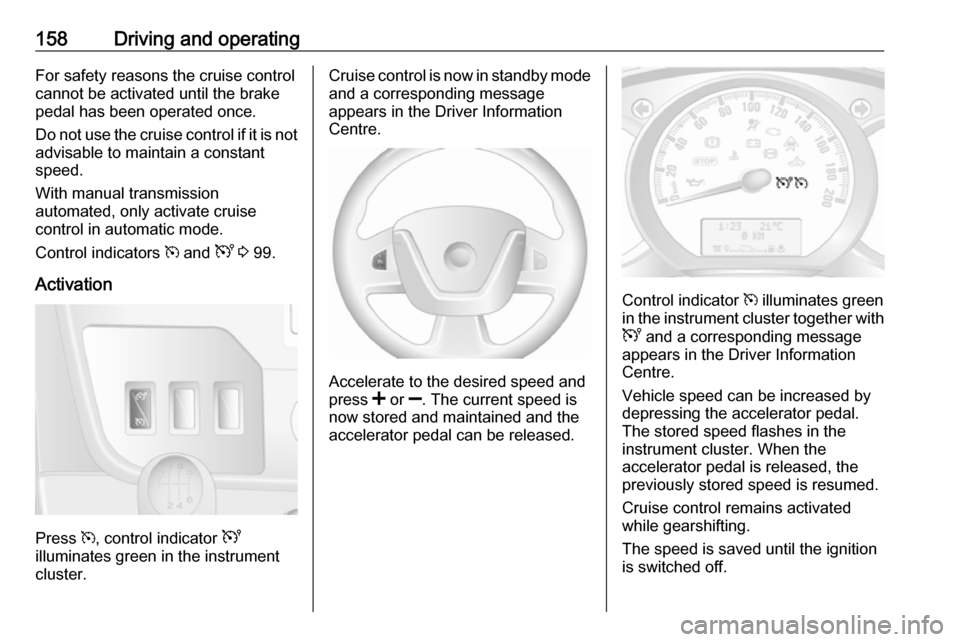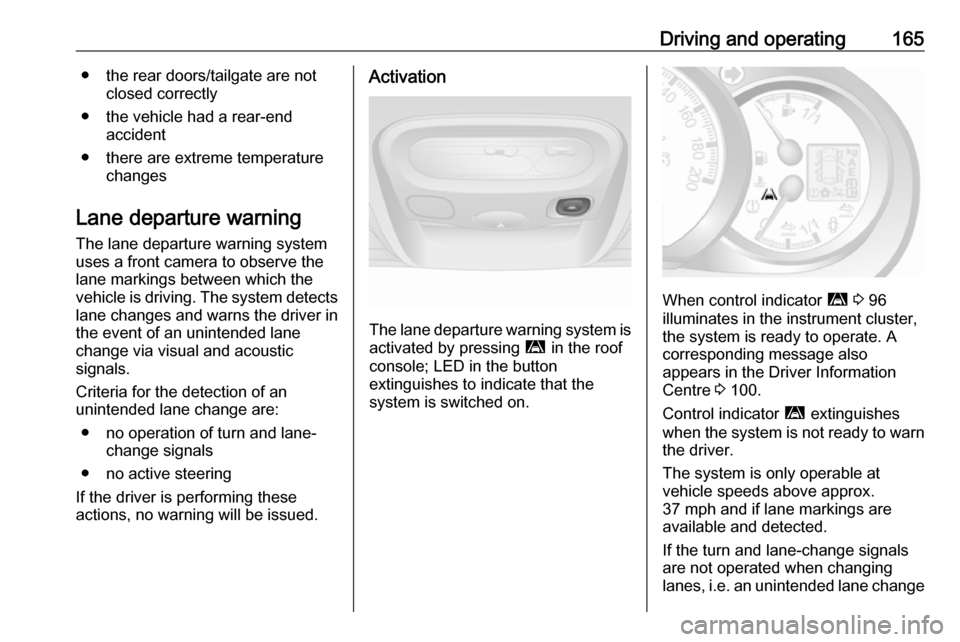2017.5 VAUXHALL MOVANO_B instrument cluster
[x] Cancel search: instrument clusterPage 159 of 259

Driving and operating157Engine Drag Torque ControlThe engine drag torque control
system is an integral feature of
ESP® Plus
. When downshifting under
slippery road conditions, the engine
speed and torque increases to help
prevent locking of the drive wheels
during sudden deceleration.
Fault
If the system detects a fault, control indicator b 3 97 illuminates together
with A 3 95 in the instrument cluster
and a corresponding message
appears in the Driver Information
Centre 3 100.
The Electronic Stability Program
(ESP® Plus
) is not operational. Have
the cause of the fault remedied by a
workshop.
Vehicle messages 3 101.
Limited-slip rear axle
Rear-wheel drive vehicles may be
equipped with an automatic locking
rear differential which automatically controls the torque transmitted toeach rear wheel, enhancing traction
in the event of soft ground, mud or
snow-covered road surfaces.9 Warning
Do not let this special safety
feature tempt you into taking risks
when driving.
Adapt speed to the road
conditions.
When vehicle speed reaches
20 mph, or once the rear wheels
return to surfaces with normal grip,
e.g. paved roads, the system
automatically deactivates,
sometimes accompanied by a noise
(with no consequence to vehicle
behaviour).
The system can also be deactivated
manually once normal grip conditions have resumed by briefly releasing the
accelerator.
Driver assistance
systems9 Warning
Driver assistance systems are
developed to support the driver
and not to replace the driver's
attention.
The driver accepts full
responsibility when driving the
vehicle.
When using driver assistance
systems, always take care
regarding the current traffic
situation.
Cruise control
The cruise control can store and
maintain speeds of 20 mph and
above. Deviations from the stored
speeds may occur when driving uphill or downhill. The stored speed will
flash in the Driver Information Centre
3 100.
Page 160 of 259

158Driving and operatingFor safety reasons the cruise control
cannot be activated until the brake
pedal has been operated once.
Do not use the cruise control if it is not advisable to maintain a constant
speed.
With manual transmission
automated, only activate cruise
control in automatic mode.
Control indicators m and U 3 99.
Activation
Press m, control indicator U
illuminates green in the instrument
cluster.
Cruise control is now in standby mode
and a corresponding message
appears in the Driver Information
Centre.
Accelerate to the desired speed and
press < or ]. The current speed is
now stored and maintained and the
accelerator pedal can be released.
Control indicator m illuminates green
in the instrument cluster together with
U and a corresponding message
appears in the Driver Information
Centre.
Vehicle speed can be increased by
depressing the accelerator pedal.
The stored speed flashes in the
instrument cluster. When the
accelerator pedal is released, the
previously stored speed is resumed.
Cruise control remains activated
while gearshifting.
The speed is saved until the ignition
is switched off.
Page 161 of 259

Driving and operating159Increase speedWith cruise control active, the vehicle
speed can be increased continuously or in small increments by holding
down or tapping < repeatedly.
When the switch is released the
current speed is stored and
maintained.
Alternatively, accelerate to the
desired speed and store by pressing
< .
Reduce speed With cruise control active, the vehicle
speed can be decreased
continuously or in small increments
by holding down or tapping ]
repeatedly.
When the switch is released the
current speed is stored and
maintained.Deactivation
Press $: cruise control is deactivated
and the green control indicator m
extinguishes in the instrument cluster.
Automatic deactivation: ● vehicle speed drops below 20 mph
● the brake pedal is depressed
● the clutch pedal is depressed
● selector lever in N
The speed is stored and a
corresponding message appears in
the Driver Information Centre.
Reactivation
Press R at a speed above 20 mph.
If the stored speed is much higher
than the current speed, the vehicle
will accelerate powerfully until the
stored speed is obtained.
Pressing < will also reactivate the
cruise control function, but at the
current vehicle speed only, not the stored speed.
Deleting the stored speedPress m: Green control indicators
U and m extinguish in the instrument
cluster.
Cruise control speed limiter
The speed limiter prevents the
vehicle exceeding a preset maximum speed above 20 mph.
Page 162 of 259

160Driving and operatingActivation
Press U, control indicator U
illuminates yellow in the instrument
cluster.
Cruise control speed limiter function
is now in standby mode and a
corresponding message appears in
the Driver Information Centre.
Accelerate to the desired speed and
press < or ]. The current speed is
recorded.
The vehicle can be driven normally
but it will not be possible to exceed the programmed speed limit except in an
emergency.
Where the limit speed cannot be
maintained, e.g. when driving on a
steep decline, the limit speed will
flash in the Driver Information Centre.
Increase limit speed
The limit speed can be increased
continuously or in small increments
by holding down or tapping <
repeatedly.
Reduce limit speed
The limit speed can be decreased
continuously or in small increments
by holding down or tapping ]
repeatedly.
Exceeding the limit speed
In the event of an emergency it is
possible to exceed the limit speed by
depressing the accelerator pedal
firmly beyond the point of resistance.
The limit speed will flash in the Driver Information Centre during this period.
Release the accelerator pedal and
the speed limiter function is
reactivated once a speed lower than
the limit speed is obtained.Notice
In vehicles fitted with a Speed
limiter, fully depressing the
accelerator pedal will not allow you
to exceed the set maximum vehicle
speed. Speed limiter 3 161.
Deactivation
Press $: speed limiter is deactivated
and the vehicle can be driven
normally.
The limit speed is stored and a
corresponding message appears in
the Driver Information Centre.
Reactivation
Press R. The speed limiter function is
reactivated.
Pressing < will also reactivate the
speed limiter function, but at the
current vehicle speed only, not the stored speed.
Deleting the limit speed
Press U.
Yellow control indicator U
extinguishes in the instrument cluster.
Page 167 of 259

Driving and operating165● the rear doors/tailgate are notclosed correctly
● the vehicle had a rear-end accident
● there are extreme temperature changes
Lane departure warning The lane departure warning systemuses a front camera to observe the
lane markings between which the
vehicle is driving. The system detects
lane changes and warns the driver in
the event of an unintended lane
change via visual and acoustic
signals.
Criteria for the detection of an
unintended lane change are:
● no operation of turn and lane- change signals
● no active steering
If the driver is performing these
actions, no warning will be issued.Activation
The lane departure warning system is activated by pressing ì in the roof
console; LED in the button
extinguishes to indicate that the
system is switched on.
When control indicator ì 3 96
illuminates in the instrument cluster,
the system is ready to operate. A
corresponding message also
appears in the Driver Information
Centre 3 100.
Control indicator ì extinguishes
when the system is not ready to warn the driver.
The system is only operable at
vehicle speeds above approx.
37 mph and if lane markings are
available and detected.
If the turn and lane-change signals
are not operated when changing
lanes, i.e. an unintended lane change
Page 219 of 259

Vehicle care217The instrument cluster and the
displays should only be cleaned using
a soft damp cloth. If necessary use a
weak soap solution.
Clean fabric upholstery with a
vacuum cleaner and brush. Remove
stains with an upholstery cleaner.
Clothing fabrics may not be
colourfast. This could cause visible
discolourations, especially on light- coloured upholstery. Removable
stains and discolourations should be
cleaned as soon as possible.
Clean seat belts with lukewarm water or interior cleaner.Caution
Close Velcro fasteners as open
Velcro fasteners on clothing could damage seat upholstery.
The same applies to clothing with
sharp-edged objects, like zips or
belts or studded jeans.
Plastic and rubber parts
Plastic and rubber parts can be
cleaned with the same cleaner as
used to clean the body. Use interior cleaner if necessary. Do not use any
other agent. Avoid solvents and petrol in particular. Do not use high-
pressure jet cleaners.
Page 254 of 259

252First aid......................................... 78
First aid kit ................................... 78
Fixed air vents ........................... 128
Fog light ....................................... 99
Fog lights ............................ 110, 186
Folding mirrors ............................. 35
Folding seat .................................. 71
Front airbag system .....................58
Front courtesy light .....................111
Front fog lights ....................106, 110
Front reading light....................... 112
Front seats.................................... 42
Front storage ................................ 71
Front turn signal lights ...............186
Fuel consumption - CO 2-
Emissions ............................... 168
Fuel economy rating (ecoScoring) ............................ 102
Fuel for diesel engines ..............166
Fuel gauge ................................... 89
Fuel tank ..................................... 242
Fuse box ............................. 193, 194
Fuses ......................................... 192
G
Gauges ......................................... 87
General information ...................169
Glass panel .................................. 40
Glovebox ..................................... 71
Glovebox cooler ......................... 128Grab handles ................................ 73
Ground clearance .......................138
H
Hand brake - see Parking brake. 153
Hazard warning flashers ............109
Headlight flash ........................... 108
Headlight range adjustment ......108
Headlights .................. 106, 107, 183
Headlights when driving abroad 108
Head restraint adjustment .............8
Head restraints ............................ 41
Heated exterior mirrors .................15
Heated mirrors ............................. 35
Heated rear window ...............15, 39
Heating ........................................ 48
Heating and ventilation system . 114
High beam ........................... 99, 107
High beam assist ..................99, 107
Hill start assist ........................... 154
Horn ....................................... 14, 82
Hub cap hook ............................. 196
I Identification plate .....................222
Idle speed control .......................134
Ignition switch positions .............132
Immobiliser .................................. 34
Indicators ...................................... 87
Info display ................................. 100
Information displays.................... 100Infotainment system ...................100
Initial drive information.................... 6
Instrument cluster ........................87
Instrument panel fuse box .........193
Instrument panel illumination .....191
Instrument panel overview ........... 10
Instrument panel storage .............70
Interior care ............................... 216
Interior lighting ............................ 111
Interior lights ...................... 111, 190
Interior mirrors .............................. 36
Interruption of power supply ......152
Introduction .................................... 3
ISOFIX .......................................... 61
J Jack ............................................ 196
Journey record............................ 102
Jump starting ............................. 211
K Keys ............................................. 19
Keys, locks ................................... 19
L
Lane departure warning .......96, 165
Lashing eyes ............................... 73
Lashing straps .............................. 73
Laying up the vehicle ..................179
Light covers, misted.................... 110
Lighting ....................................... 106